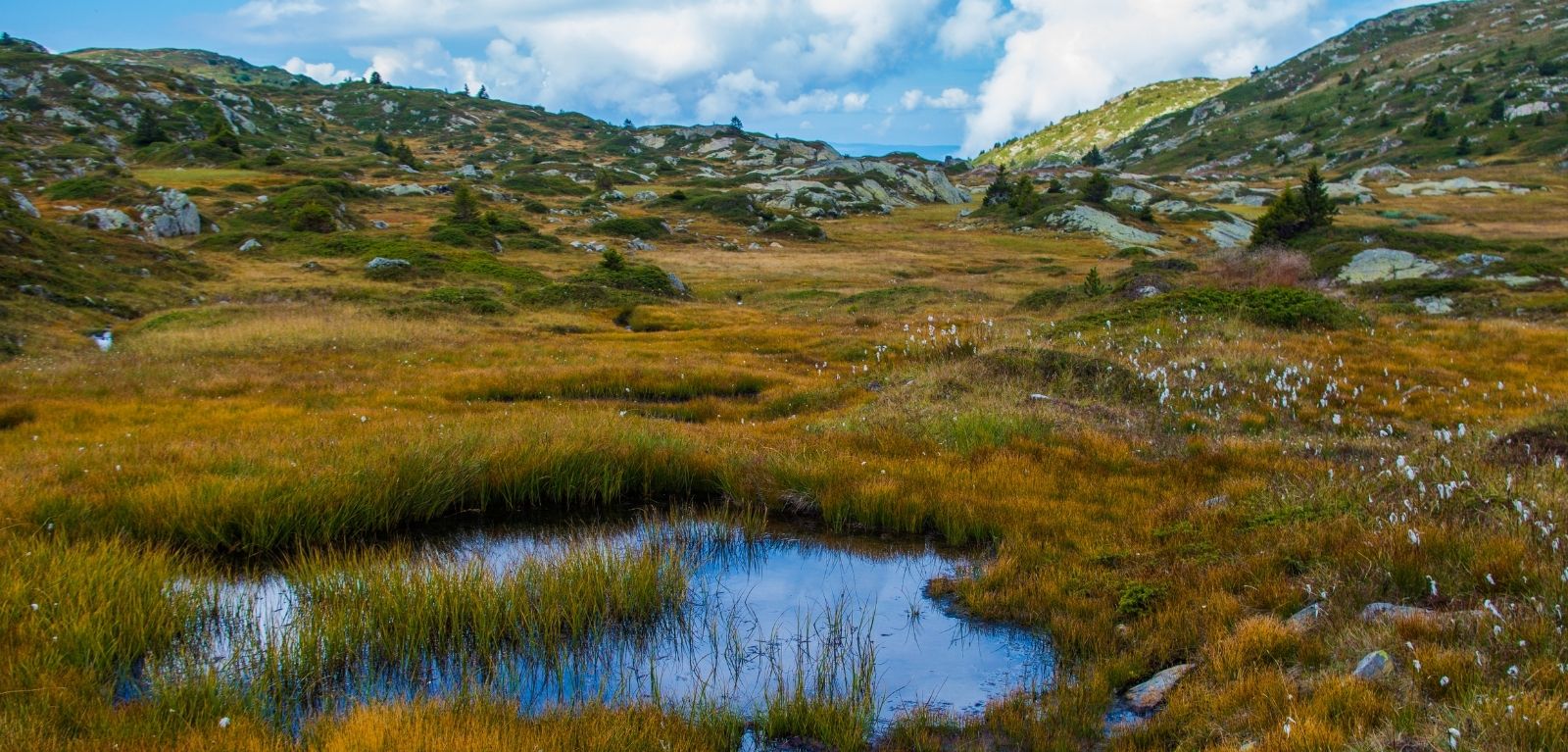Letting nature breathe: Working with biodiversity to mitigate against climate change

As part of our special blog series, Queen's Voices on COP26, Professor Mark Emmerson from the School of Biological Sciences, explains why Climate and biodiversity change are inextricably linked, and discusses the role of the All-Island Climate and Biodiversity Research Network (AICBRN), launched today (Tuesday 9 November) by Taoiseach Micheál Martin and Deputy First Minister Michelle O’Neill.
With an overwhelming focus on COP26 and the climate crisis, it is very easy to lose sight of the role played by nature in mitigating climate change impacts. Earlier in October, preceding COP26 in Glasgow by just a couple of weeks, the UN biodiversity conference COP15 was held virtually and saw the adoption of the Kunming declaration.
The Kunming declaration states that all Parties to the convention are committed to developing, implementing and monitoring an effective framework that will put biodiversity on the path to recovery by 2030. The declaration’s ultimate goal is “living in harmony with nature” by 2050. While final decisions and implementation of the framework will not be agreed until April 2022 when COP15 reconvenes, a number of major signatories have already announced a number of national initiatives that will hopefully set them on the road to achieving the 2030 and 2050 goals.
At a European level, the Biodiversity Strategy for 2030, developed under the Green Deal aims to develop an EU wide network of managed and protected areas encompassing 30% of the land and 30% of the seas by 2030. The Farm to Fork Strategy, also developed under the Green Deal, provides a focus on driving change in food systems, with an emphasis on minimizing impacts on the environment, reducing biodiversity loss and mitigating against the impacts of climate change.
At a UK level the Joint Nature Conservation Committee (JNCC) recently published its Nature Positive 2030 report to identify how the UK can succeed in achieving the 30by30 commitment to protect 30% of our land and seas by 2030. The report has a number of headline messages, but very explicitly recognises the need to go high-nature and low-carbon, tackling the twin crises of biodiversity loss and climate change together.
Ultimately, the climate and biodiversity crises share many of the same causes and solutions, and the JNCC’s report articulates the need to tackle both together or we tackle neither. If wildlife habitats can be restored on land and at sea, then they can lock up carbon mitigating potential impacts and enabling us to adapt to future climate change. Habitats such as peat bogs, saltmarshes, woodlands, hedges and arable margins can all lock up carbon, but they also provide a range of other services and solutions. For example, degraded peat bogs actually emit about 23 million tonnes of CO2 annually, that’s about 5% of all UK emissions, because they have been drained and degraded.
Yet, if we can restore them, they can begin to lock up carbon acting as carbon sinks, with peatlands currently storing around 3 billion tonnes of carbon in the UK alone. Peatlands also help slow water flow during storms, reducing erosion and improving water quality, which reduced costs associated with drinking water treatments. Woodlands sequester about 4.6% of UK total emissions, and store around 1.09 billion tonnes of carbon, but they cover just 13% of the UK land area. Woodlands provide adaptation by reducing flood risks and in the face of a warmer world, provide shade and cooling in urban and rural settings.
There are many other habitat types that provide a range of Nature Based Solutions, which are well described in a recent landmark report “Nature-based solutions for climate change in the UK: A report by the British Ecological Society” published earlier this year. The British Ecological Society is the World’s oldest and Europe’s largest ecological society and undertakes a range of activities including education, outreach, and research through its grant schemes. They produce an annual report focused on pressing issues of concern and this year’s was a focus on Nature Based Solutions (NBS).
As Vice President for the Society, I am the chair of the Grants Committee and many of our awards are directed towards Early Career Ecologists working at the interface of climate and biodiversity change. Over the course of the coming year the society will be focusing on protected areas to help provide the evidence base to underpin the 30by30 commitments. The conclusion of the BES report about Nature Based Solutions is that they are a key part of the toolbox and jigsaw that make up the landscape of mitigation and adaptation solutions; they cannot be used successfully unless there are reductions in emissions overall. In this way, we have to use Nature Based Solutions in combination with a range of other approaches, to deliver integrated solutions to help mitigate the climate and biodiversity crises.
To try and achieve this goal of delivering integrated solutions, here at Queen’s University Belfast, we have been working together over the course of the last two years with colleagues from across our three faculties to both advance the sustainability agenda internally, and to work with colleagues on an All-Island basis.
In December 2019, we held the inaugural meeting of the All-Island Climate and Biodiversity Research Network, an interdisciplinary network of leading academics from across the Island of Ireland representing a mixture of Centres, Institutes and Schools distributed across a number of HEIs. The network provides a platform for coordination of research, and brings together colleagues working in the climate and biodiversity domains, reflecting the natural and social sciences, as well as engineering and economics, to focus on the dual problems of climate and biodiversity change. Importantly, the Network places integrated solutions at the heart of addressing the climate and biodiversity crises and views these as a joint challenge to be addressed.
Climate and biodiversity change are linked inextricably, and we cannot consider one without consideration of the other. Simplistically, climate change contributes to biodiversity change and loss, whilst biodiversity can mitigate climate change and helps to make systems more resilient. Of course, it is never quite as simple as that! The climate and biodiversity crises are massively complicated challenges that will require an unprecedented response involving a diverse, yet integrated, range of disciplines providing the disparate knowledge that when brought together can deliver both understanding and solutions. These solutions will require contributions from all sectors of society and will probably require some changes in lifestyle that we might find difficult.
Underpinning the All-Ireland Climate and Biodiversity Research Network, is our ambition to develop a large-scale research and innovation initiative that can help improve good public policy and management decisions, underpin business and enterprise strategies, and strengthen societal capacity to address the climate and biodiversity emergencies.
The building blocks needed to understand climate science and the ecological principles that underpin biodiversity change exist and are well understood, but they represent approaches across disciplines and bringing these approaches together is not so easy when we have lacked a forum or platform to engage in these conversations across the climate and biodiversity interface. The AICBRN provides that grass roots forum, initially bringing together leading researchers from a wide range of disciplines with some strategic oversight of the research landscape in Ireland, but also across the wider UK and into Europe and beyond.
Over the course of the last two years, we have developed a shared vision of what needs to be done; that vision is reflected in a that we developed and have used as a calling card to start conversations with research agencies, relevant public sector bodies, government departments, and regional development agencies on an All-Island of Ireland basis. The green paper gives voice to our ambitions for a step change in collaborative endeavours, funded over the longer term at timescales relevant to the biodiversity and climate crises, but which are also urgently needed.
If we are to achieve 2050 targets for Net Zero, then solutions need to be provided quickly. We need to reduce the time it takes for research to pass along the Technology Readiness Level pipeline and be translated into practice. We also need to recognise that much research is not commercially relevant, but rather is undertaken to provide the evidence base to underpin policy development, which in turn has a role in influencing business and industry, as well as societal behaviours.
The network provides a forum where we can develop sustainable solutions with the potential for more effective spending of research funds, and provides a vehicle for collaboration between the production sector, including agriculture, forestry and marine, and researchers working on climate and biodiversity change needed to translate fundamental research into practice. Working together through the network, we can optimise existing research investments, identify critically needed infrastructure, and develop teams capable of not only addressing the challenge, but becoming more successful at securing the competitive research funding that is needed.
A central focus on the Network is the delivery of integrated solutions to address the biodiversity and climate challenges that Ireland, the UK, and the rest of the world faces. Technology based Solutions provide the demonstration platforms at scale and embedded with industry. They include anaerobic digesters, bioreactors, smart transport infrastructure, or community based platforms that can trial interventions proposed by the network. Engineering based Solutions include the built and physical environment and include sustainable building designs, transport infrastructure and hard environmental protection measures. As we have already seen, Nature based Solutions are actions that work with and enhance nature to provide benefits to society. This includes the capacity to act as carbon sinks or to mitigate and ameliorate against natural disasters, for example, flood alleviation and coastal protection, whilst Societal based Solutions are those focused on providing policy based interventions that enable societal change and that do not lead to perverse outcomes or behaviours within the letter of the law.
Our goal through the research network is to provide solutions to support agriculture, forestry, marine, industry and policy needs, with solutions founded on a strong basis of cutting-edge research and on an understanding of the highly connected earth system. Ultimately, nature can help us survive an uncertain future in the face of climate change, but nature alone does not provide a panacea, its ability to provide solutions depends on having biodiverse ecosystems that are resilient to climatic changes. This is a challenge over which we cannot afford to fail.
